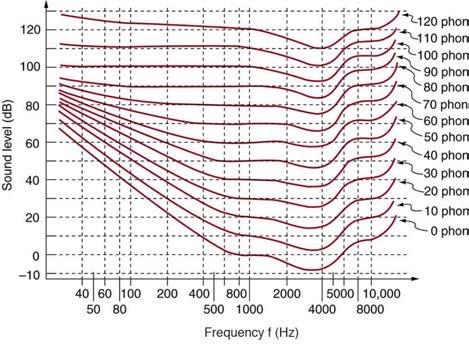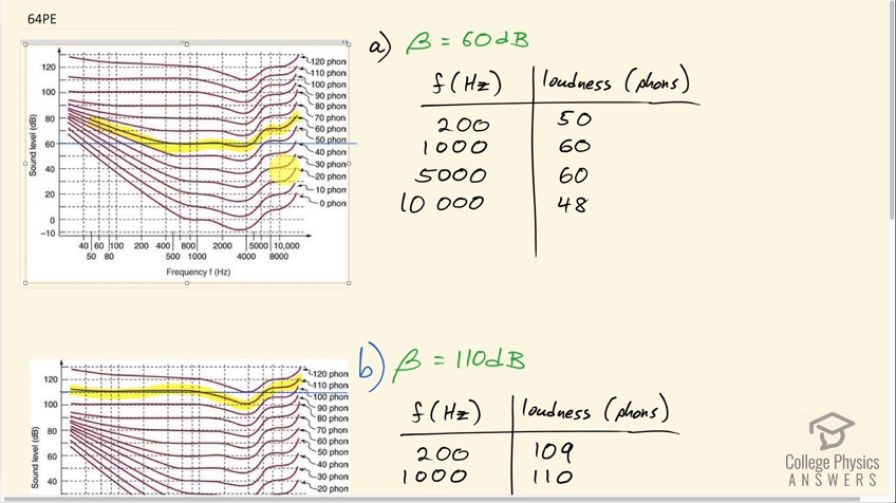Question
(a) What are the loudnesses in phons of sounds having frequencies of 200, 1000, 5000, and 10,000 Hz, if they are all at the same 60.0-dB sound intensity level? (b) If they are all at 110 dB? (c) If they are all at 20.0 dB?

Final Answer
-
f (Hz) loudness (phons) 200 50 1000 60 5000 60 10000 48 -
f (Hz) loudness (phons) 200 109 1000 110 5000 118 10000 105 -
f (Hz) loudness (phons) 200 not audible 1000 20 5000 21 10000 10
Solution video
OpenStax College Physics for AP® Courses, Chapter 17, Problem 64 (Problems & Exercises)

vote with a rating of
votes with an average rating of
.
Video Transcript
This is College Physics Answers with Shaun Dychko. For a given sound intensity level, we are going to figure out what is the perceived loudness at different frequencies. So the sound intensity level is in decibels so in part (a) we have 60 decibels. So on this graph of sound level on the vertical axis and frequency on the horizontal axis, we put a horizontal line at 60 decibels and we see where it crosses these red curved lines which are for given perceived loudness level, the perceived phons— the unit of phons measures what is the human perceived loudness of a sound at different frequencies. So at 1000 hertz, the phons will always be the same as the sound level so at 1000 hertz, we'll have 60 phons; at 200 hertz, we have to draw a line upwards from 200, see where it crosses the sound level of 60 decibels and then figure out which curved phon line it's closest to. So I have highlighted the 60 phons line here and this seems across the line that is below that which is 50 phons and so that's why I have 50 phons here for the loudness at 200 hertz given a sound level of 60 decibels. Okay! And then it's the same process all through all these different questions. So we have 5000 hertz, we draw a line upwards and then make it perfectly vertical and then it seems to cross right on this 60 phons line so we have the 60 there and then for 10000 hertz, we draw a line upwards... and it crosses the 60 decibel blue line here which is just below the 50 phons curved line and so let's call it about 48 phons. Okay! Then in part (b), we are told consider a sound level of 110 decibels and so we make a horizontal blue line at 110 decibels and then I have highlighted this 110 decibel phons curve just to be able to see it more easily and then we make vertical lines at 200 hertz, 5000 hertz and 10000 hertz; no need to do anything at 1000 hertz because it's always going to be the same loudness in phons as the sound level is in decibels. So for 1000 hertz, it's 110 phons; for 200 hertz, let's make a line straight up and it seems to cross slightly below this 110 phons line, let's call it 109; for 5000 hertz, we go straight up here and it crosses this blue line just below the 120 phons line let's call that 118 or so. And then for 10000 hertz frequency, it crosses midway between 110 phons and 100 phons line so it's 105. And then we consider a sound level of 20.0 decibels and at 1000 hertz of course the loudness perceived in phons will be 20 just the same as the sound level is in decibels. At 200 hertz, we draw a line straight upwards and we can see that it intersects the 20.0 decibel sound level just below this line corresponding to zero phons and so being below zero phons means this sound will not be audible at all. So 20.0 decibel sound with a frequency of 200 hertz will not be audible to somebody with normal hearing. At 5000 hertz, let's draw a line straight up at 5000 it crosses the 20 phons line there... maybe slightly above and so let's call that 21 and at 10000 hertz, we draw a line straight up and it crosses right on the 10 phons line and so we call it 10 phons for 10000 hertz and there we go!